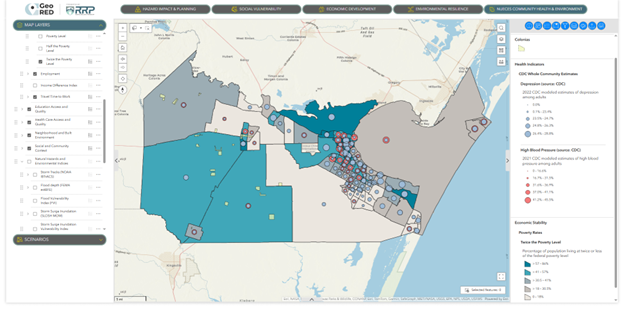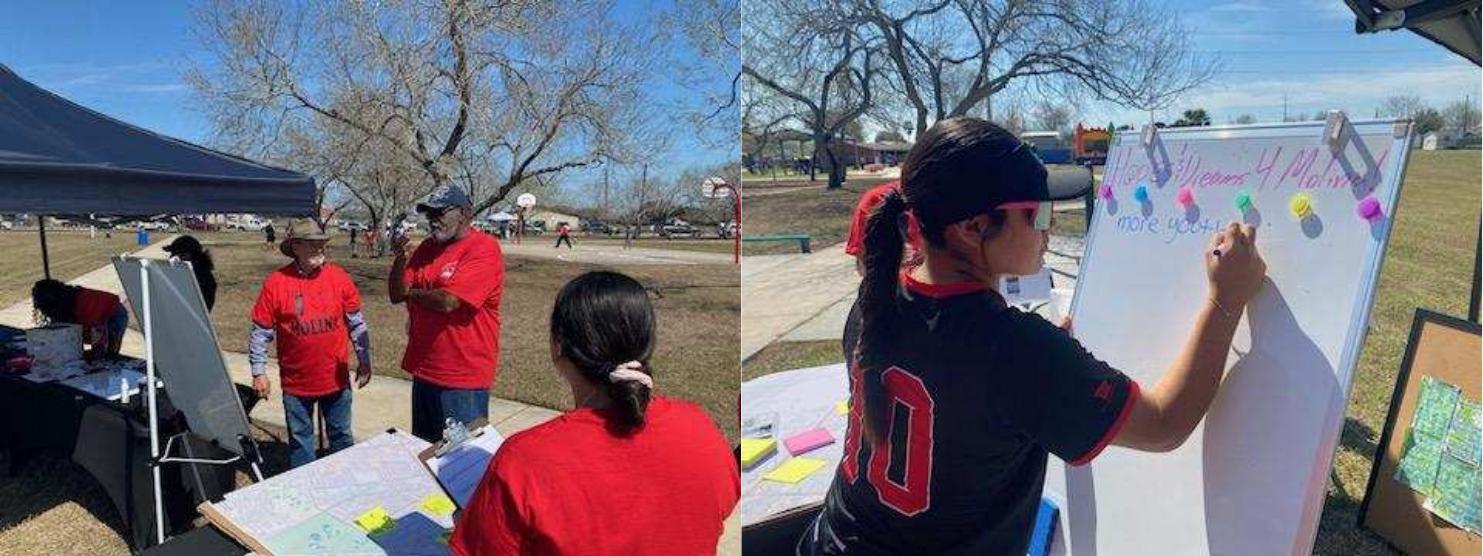Social Determinants of Health Data Integration Barriers in Nueces County, Texas
Funded by the Gulf Research Program of the National Academies of Sciences, Engineering, and Medicine and the Robert Wood Johnson Foundation.
The Challenge
Despite the impact SDOHs have on health outcomes, it is not well understood how data on the conditions in which people live, grow, work and age can be integrated with health data systems. Improving this understanding is critical, especially for communities and neighborhoods where non-medical factors may disproportionately impact well-being and quality of life.
Such is the case in Nueces County, Texas. The largest city in the county is Corpus Christi, which is ranked 9th in the nation as the most economically disadvantaged, and 6th in the nation as the highest in food insecurity. Of the county’s 353,178 residents, 62% are Hispanic. Many of these communities, such as those in the Westside of Corpus Christi, have faced historic discrimination that has contributed to significant health disparities. For example, in a low socioeconomic status community of color in the Westside neighborhood of Molina, the life expectancy rate is 70 years, whereas just 10 miles away individuals of high socioeconomic status can expect to live 85 years. This stark difference becomes clearer when examining chronic diseases in Molina, which has higher rates of hypertension, diabetes, obesity, asthma, and depression.
This project sought to better understand health disparity in Molina and additional at-risk communities in Nueces County that may stem from SDOHs. These SDOHs were also linked to climate and environmental factors, with the explicit goal of facilitating the integration of data on key SDOH and environmental factors to improve health outcomes. All health, SDOHs and environmental factors were selected in collaboration with the project’s Action Committee of local experts. This group also guided the methods and informed the results of the project for locally-tailored solutions.
The Approach
Given the complexity of challenges in Nueces County and Molina, this project incorporated the principles of Community-based Participatory Research (CBPR) through a mixed-methods approach to analyze linkages between major health disparities, SDOHs, climate and environmental factors, with focus on flooding and storms, air quality and urban heat.

An interdisciplinary team worked with local experts through the project’s Action Committee to co-design and co-produce a set of tools that address the challenge of understanding and integrating SDOH, climate and environmental data for improved decision-making.
Locally Tailored Products
- The geospatial Nueces County Community Health & Environment Tool can be used by diverse decision-makers to better understand SDOH and environmental factors in Nueces County and how such factors may be interplaying with health.
- The tool organizes health, SDOH and environmental data at the census tract level.
- The tool also makes all data available for download such that interested users can easily access the data for integration into their own external analyses.
- The tool further provides summary statistics to add depth and context for local needs assessments, grant writing, and to provide a snapshot across communities that can be used to better target scarce resources.

Example analysis enabled in the Community Health & Environment Tool for Nueces County, Texas. Data are grouped into SDOH categories. Image shows CDC data on depression rates and rates of high blood pressure, overlaid on poverty data (twice the federal poverty level).
- SDOH Logic Models are available for all five health outcomes of concern for the project: asthma, diabetes, hypertension, obesity and depression. Informed by peer-reviewed literature and state and local reports, the Action Committee SDOH Logic Model Working Group used their local knowledge to identify relevant connections between specific SDOHs and health outcomes, helped the project team visualize these connections and, where feasible, made links to local data.
- The models serve as a guide for decision-makers that are looking to investigate underlying social, economic and environmental factors that impact health outcomes in Nueces County.
- For each health outcome, health practitioners and others can use the models to triangulate specific datasets to view in the tool when assessing social, economic and environmental impacts to health.
- The logic models and accompanying Evidence Library detail the different types of evidence used to build the models. This includes peer reviewed literature, state and local assessments and statistical modeling as well as local knowledge provided by the Action Committee and through on-the-ground engagement with the Molina community
- The models serve as a guide for decision-makers that are looking to investigate underlying social, economic and environmental factors that impact health outcomes in Nueces County.

- SDOH Data Integration Framework provides background and operational guidance on how health practitioners and others can address the challenge of integrating SDOH data.
- Co-produced with the Action Committee SDOH Data Integration Working Group, it provides step by step guidance on how to integrate curated data for Nueces County that is available for download through the Nueces Community Health & Environment Tool.
- Priority Recommendations for Action offers a discrete set of actions that key partners have agreed to move forward. The Community Resilience Center and the Corpus Christi-Nueces County Public Health District will use this document to continue this work.
- The document also further details the deep engagement conducted in the Molina neighborhood and the lessons learned that will continue to inform future work.






